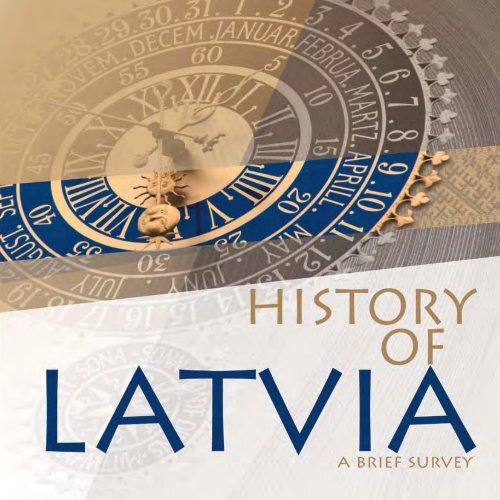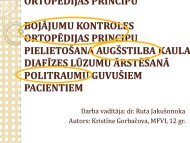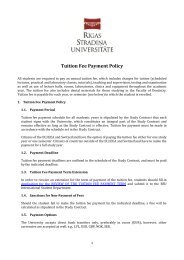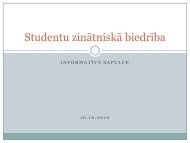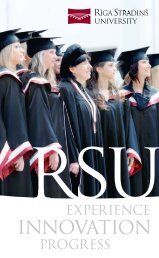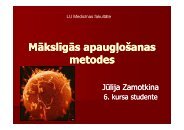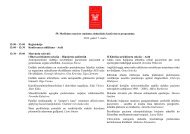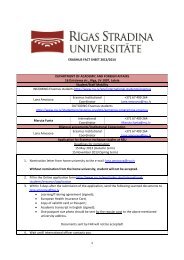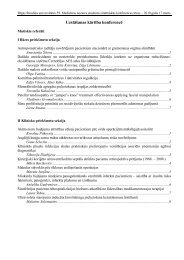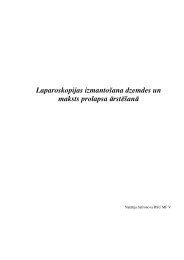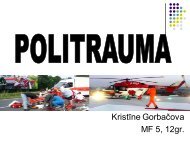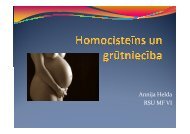History of Latvia: a Brief Survey
History of Latvia: a Brief Survey
History of Latvia: a Brief Survey
- No tags were found...
Create successful ePaper yourself
Turn your PDF publications into a flip-book with our unique Google optimized e-Paper software.
In the AD 900s, the ancient Balts began to establish definabletribal realms. Gradually, four individual Baltic tribal culturesdeveloped: Couronians, Latgallians, Selonians, Semigallians(kurši, latgaļi, sēļi, and zemgaļi). The largest <strong>of</strong> them was theLatgallian tribe, which had the most advanced socio-politicaldevelopment.In the 1100s and 1200s, the Couronians were aggressive people,engaged in raiding, looting and pillaging. Located on the westcoast <strong>of</strong> the Baltic, they became known as the ‘Baltic Vikings’.Their contemporaries, the inland Latgallians, Selonians andSemigallians, were known as peace-loving and prosperousfarmers. The Latgallians had the most advanced state-likeformations (civitates in medieval Latin chronicles): Atzele, Jersika,Koknese and Tālava.4Ancient Latgallians and their clothing, 11-13th centuries.
Āraiši – a reconstructed lake-dwellingsettlement <strong>of</strong> ancient Balts, 9th century.Jewellery <strong>of</strong> the ancient Balts, 6-11thcenturies: crossbow brooches, bracelet.dēli (Sons <strong>of</strong> God), Laima (Fate or Fortune) and other deities, mainly maternal figures —female patronesses <strong>of</strong> some specific activities or places (Mother <strong>of</strong> the Sea, Mother <strong>of</strong> theForests etc.). One <strong>of</strong> the most important gods was the god <strong>of</strong> thunder and storms, Pērkons,who fertilised the earth and cleared it <strong>of</strong> the power <strong>of</strong> evil. Pērkons was imagined as a stern,bearded and powerfully built man who traversed the sky in a fiery chariot drawn by swifthorses, or as riding a fiery horse. His head was crowned with a wreath <strong>of</strong> flames. In one handhe held lightning bolts, and in the other, a heavy stone axe. Historical records and Balticfolklore have preserved the names and functions <strong>of</strong> about 200 Baltic gods and goddesses.A Namejs ring, named after thelegendary 13th century Semigallianleader, Namejs. Historical informationsuggests that this identifying symbolwas worn by ancient Semigalliannobility. Today it is worn as an assertion<strong>of</strong> <strong>Latvia</strong>n identity.6Written sources <strong>of</strong> the 13th century list the names <strong>of</strong> some <strong>of</strong> the greatest leaders or kings<strong>of</strong> the Baltic and Finno-Ugrian tribes: Lamekins among the Couronians, Tālivaldis among theLatgallians, Namejs (Nameisis) and Viestarts amongthe Semigallians, and Ako and Kaupo among the Livs.The most renowned leader was Semigallian Namejs,almost a mythical figure in modern <strong>Latvia</strong>n literature.He is believed to have attempted a significant militarycampaign in 1286, <strong>of</strong> allied Baltic tribes against theinvading German military contingent known asthe Livonian Order (Latin: Fratres militiae Christi deLivonia).
12th century-1914The Age <strong>of</strong>German, Polish,Swedish, and RussianRule in <strong>Latvia</strong>Because <strong>of</strong> its strategic geographic location, the <strong>Latvia</strong>n territory was frequentlyinvaded by neighbouring nations, largely defining the fate <strong>of</strong> <strong>Latvia</strong> and its people.By the late 12th century, <strong>Latvia</strong> was increasingly visited by traders from WesternEurope who used <strong>Latvia</strong>’s longest river, the Daugava, as a trade route to Russia.Compared with other countries around Europe, Christianity arrived in the territory <strong>of</strong><strong>Latvia</strong> relatively late. German traders appeared at the close <strong>of</strong> the 12th century, bringingwith them missionaries who attempted to convert the pagan Baltic and Finno-Ugriantribes to the Christian faith. Out <strong>of</strong> loyalty to their ancient pantheistic beliefs, the Baltsresisted the imposition <strong>of</strong> a foreign religion, especially the ritual <strong>of</strong> christening.In 1198 Pope Innocent III proclaimed a crusade against the Baltic peoples, without anysignificant results. In 1199 Albert <strong>of</strong> Buxhoeveden (c.1165-1229) was named as a Bishop<strong>of</strong> Ikšķile — also where the first western church in the territory <strong>of</strong> <strong>Latvia</strong> was located. Heconvinced Innocent III to proclaim a second Baltic crusade. In the spring <strong>of</strong> 1200, twenty-three8A fragment <strong>of</strong> the Latin text <strong>of</strong> the‘Heinricus’ Livonian Chronicle’ (HeinriciChronicon Livoniae), which depictedevents in the territory <strong>of</strong> <strong>Latvia</strong> between1180 and 1227. In this fragment, from a17th century copy <strong>of</strong> the chronicle, thefoundation <strong>of</strong> Rīga in 1201 is described.The emblem <strong>of</strong> the Livonian Brothers<strong>of</strong> the Sword, later called the LivonianOrder.The seal <strong>of</strong> Bishop Albert, the founder<strong>of</strong> Rīga, 1225.
A battle between the Couronians and the German crusaders nearthe coast <strong>of</strong> Gotland in the Baltic Sea, 18 April 1210. It was thegreatest victory <strong>of</strong> the ancient <strong>Latvia</strong>ns over the crusaders in theBaltic Sea.The stamp <strong>of</strong> Rīga city in 1225.ships and five hundred armed German soldierswere hired to assist the Christian missionaries ina campaign to forcibly convert the people <strong>of</strong> theregion. In 1201 Bishop Albert began building thecity <strong>of</strong> Rīga near the mouth <strong>of</strong> the river Daugava,where Liv villages were located on the RīdzeneRiver. Rīga became the largest and most powerfulcity on the southern coast <strong>of</strong> the Baltic Sea. Thefounding <strong>of</strong> Rīga was the beginning <strong>of</strong> urban historyin the whole Baltic area.An image <strong>of</strong> Pope Innocent III (whowas Pope 1198-1216) from a medievaldocument. A papal bull issued byInnocent III began the second crusade inthe Baltic territory.Structure <strong>of</strong> the Holy Roman Empire.Illustrations from the NurembergChronicle (Die Schedelsche Weltchronik),by Hartmann Schedel (1440-1514).As the German soldiers <strong>of</strong> the Livonian Order seized control <strong>of</strong> the region, the development<strong>of</strong> separate tribal realms and state-like formations in ancient <strong>Latvia</strong> came to an end.Among religious orders, Cistercians and Dominicans played the most important role inLivonia. The Cistercians established the first monastery in Daugavgrīva (German: Dünamünde)in 1205-1207 which became a sort <strong>of</strong> Western diplomatic centre in the Baltics. In the1200s,a confederation <strong>of</strong> feudal nations was developed under German rule and named Livonia.The territory included today’s <strong>Latvia</strong> and Estonia. The confederation <strong>of</strong> Livonia remainedan important factor in the politics <strong>of</strong> Northern Europe until the second half <strong>of</strong> the 16thcentury. Livonia was the part <strong>of</strong> a mainly Germanic conglomeration <strong>of</strong> lands <strong>of</strong> the HolyRoman Empire.9
Walter von Plettenberg (c.1450-1535),Master <strong>of</strong> the Livonian Order (1494–1535) and one <strong>of</strong> the greatest leaders <strong>of</strong>the Livonian knights.The coat <strong>of</strong> arms <strong>of</strong> Rīga 1349.In 1282, Rīga and later Cēsis, Limbaži, Koknese, Kuldīga, and Valmiera were included in thenorthern German trading organisation, the Hanseatic League (Hansa). Rīga subsequentlybecame an important centre not only for east-west trade, but for the entire eastern Balticregion, developing close cultural contacts with Western Europe.The stamp <strong>of</strong> Rīga city in 1368.A map <strong>of</strong> Hansa cities from 1539 (Cartamarina et Descriptio septemtrionaliumterrarum ac mirabilium rerum in eiscontentarum, diligentissime elaborataAnno Domini 1539 Veneciis liberalitateReverendissimi Domini Ieronimi Quirini).10The 16th century was a time <strong>of</strong> great change for the inhabitants <strong>of</strong> <strong>Latvia</strong>, notable for theReformation and the collapse <strong>of</strong> the Livonian nation.In the late 15th and early 16th centuries, relations with Russia became strained. In 1501Walter von Plettenberg (c.1450-1535), the Master <strong>of</strong> the Livonian Order, managed to gatherthe forces <strong>of</strong> Livonia to successfully fight the invading Russians. He captured several Russianstrongholds, including Pskov, Ostrov, Izborsk and Ivangorod, and besieged Novgorod, butfailed to protect Livonia against devastating Russian raids. Plettenberg made an alliance withthe Lithuanian Grand Prince Alexander against the Russians. He even tried to convince the
Pope Alexander VI to issue a crusading bull against the Russians. Finally he made peace withGrand Prince Ivan III <strong>of</strong> Muscovy in Pskov in 1503, but with no territorial changes. Plettenbergcan be considered one <strong>of</strong> the most gifted political leaders <strong>of</strong> Livonia.After Martin Luther posted his theses in 1517, Lutheran ideas began to emerge in Livonia. Inthe early 1520s Rīga became an important centre <strong>of</strong> Reformation ideas in Northern Europe.By the mid-16th century Lutheranism had become dominant among ruling elites.After the so-called Livonian War (1558-1583) — a lengthy military conflict between Russiaand its western neighbours for control <strong>of</strong> present-day <strong>Latvia</strong> and Estonia — <strong>Latvia</strong>n territorycame under Polish-Lithuanian rule. The confederation <strong>of</strong> Livonia ceased to exist. The ones tobenefit most from the new political situation were the knights <strong>of</strong> the <strong>of</strong> the Livonian Order. In1562 the Order was secularised, and its last master Gotthard Kettler (1517-1587) became theduke <strong>of</strong> a new province called Courland-Semigallia (abbreviated Courland, today Kurzeme-Zemgale).Free city <strong>of</strong> Rīga 1 Schilling, 1570.An old map <strong>of</strong> Livonia, firstpublished in 1573.An old map <strong>of</strong> Livonia, firstpublished in 1573.The coat <strong>of</strong> arms <strong>of</strong> Rīga, 1586.11
Luther’s Small Catechism (Enchiridion),published in <strong>Latvia</strong>n in 1586 — one<strong>of</strong> the first books to be published in<strong>Latvia</strong>n.12The Lutheran Reformation and Catholic Counter-Reformation in Livonia stimulated the consolidation<strong>of</strong> the <strong>Latvia</strong>n nation and emergence <strong>of</strong> the written<strong>Latvia</strong>n language. The first books in the <strong>Latvia</strong>nlanguage were published. The two churches competedfor membership by publishing texts in <strong>Latvia</strong>n.Following the Catholics’ printing <strong>of</strong> the CathechismusCatholicorum in 1585, the Lutheran church printed itsown catechism, the Enchiridion, in 1586. The Lutheranfaith was accepted in Kurzeme (Courland), Zemgale(Semigallia) and Vidzeme (Livland), but the RomanCatholic faith maintained its dominance in the easternterritory <strong>of</strong> <strong>Latvia</strong> — Latgale (Inflanty or Polish Latgale,Latgallia). It remains so to this day.In the 1600s, the Duchy <strong>of</strong> Courland, once a part <strong>of</strong>
The economy <strong>of</strong> Courland flourished,especially in ship-building andmetallurgy, under the rule <strong>of</strong> JacobKettler in the mid-1600s.Jacob Kettler (1610-1682), the Duke <strong>of</strong>Courland (Kurzeme).A map <strong>of</strong> James Island in the GambiaRiver estuary and Tobago Island —colonies <strong>of</strong> Courland in the 17thcentury.The naval flag <strong>of</strong> the Duchy <strong>of</strong> Courlandwith the Duchy’s symbol — a lobster.Livonia experienced a notable economic boom. The most successful ruler in the Duchy was Duke Jacob Kettler (1610-1682). Duringthe period <strong>of</strong> his rule (1642-1682) Kurzeme became a regional power to be reckoned with. He established two colonies: an islandin the estuary <strong>of</strong> the Gambia River in Africa and Tobago Island in the Caribbean Sea. Both were successful ventures until the end <strong>of</strong>Jacob’s reign, when the Duchy’s navy fell apart, but the Couronian place names from this period are still evident there today.13
Rīga in 1612.However, during this time, the Duchy <strong>of</strong> Courland remained an object <strong>of</strong> interest for bothSweden and Poland. In 1621, during the Polish-Swedish war (1600-1629), Latgale remainedunder Polish control, but Vidzeme and Rīga came under Swedish rule, overshadowingStockholm as the largest and most developed city in the Swedish kingdom. Rīga waseconomically and culturally part <strong>of</strong> a growing urban network linking the major states andcultures <strong>of</strong> Western, Eastern and Northern Europe. During this period the region <strong>of</strong> Vidzemewas known as the ‘Swedish bread basket’ because it supplied the larger part <strong>of</strong> the Swedishkingdom with wheat.Awareness <strong>of</strong> the <strong>Latvia</strong>n identity began in the 17th century. The Couronians, Latgallians,Selonians, Semigallians and part <strong>of</strong> the Livs began to identify as a culturally unified nation —the <strong>Latvia</strong>ns (latvieši). Most <strong>of</strong> the <strong>Latvia</strong>n population were farmers and by the second half <strong>of</strong>the 17th century, most <strong>of</strong> them were serfs.In the early 18th century, the Great Northern War broke out, largely as a result <strong>of</strong> the RussianEmpire’s desire to expand its territorial claims to the strategically important territory <strong>of</strong> <strong>Latvia</strong>.One <strong>of</strong> its key goals was to secure and control the wealthy and prestigious city <strong>of</strong> Rīga.14
The Port <strong>of</strong> Rīga in 1650 — loading <strong>of</strong>herring.The Great Northern War in the territory<strong>of</strong> <strong>Latvia</strong>. The King <strong>of</strong> Sweden, Karl XII,and his army fording the Daugava Rivernear Rīga, July 1701.15
Dome Cathedral in Rīga, 1780s.In 1710, the Russian Tsar, Peter I, conquered Vidzeme. The combination <strong>of</strong> Vidzeme andRīga provided Russia with a clear passage to Europe via the Baltic Sea. In 1772 the RussianEmpire as a result <strong>of</strong> First Polish partition gained Latgale. In reorganising its new territories,the Russian government abolished Latgale as a separate unit and divided it into separatedistricts in the Russian-dominated Polotsk province. After the Great Northern War the Russianimperial influence steadily grew in the Duchy <strong>of</strong> Courland. By the end <strong>of</strong> the 18th century, all<strong>of</strong> <strong>Latvia</strong>’s territory was under Russian rule — Courland became part <strong>of</strong> the Russian Empirein 1795.The first Bible in the <strong>Latvia</strong>nlanguage (New and Old Testaments)was translated by Johann Ernst Glück(1654-1705), a Lutheran priest <strong>of</strong>German origin, and was published inRīga in 1689.16
<strong>Latvia</strong>n celebration <strong>of</strong> wedding (18th century drawing),which since ancient times has been associated with anabundance <strong>of</strong> food and drink. It is hard to imagine a<strong>Latvia</strong>n wedding without the ancient festive dishes —pīrāgi (bacon rolls), sweet platter breads and beer.17
Krišjānis Valdemārs (1825-1891), main ideologue <strong>of</strong>the New <strong>Latvia</strong>n movement and the most prominentsocial and political figure <strong>of</strong> the time; publicist,editor <strong>of</strong> the Peterburgas Awizes. Valdemārs’ ideashave been very influential in the development <strong>of</strong>national romanticism and the history <strong>of</strong> <strong>Latvia</strong>npublic opinion. He also played a large role in the thedevelopment <strong>of</strong> <strong>Latvia</strong>n seafaring.Barquentine Anna Wictoria, built in 1878 in Ainaži. The firsttwo <strong>Latvia</strong>n peasant-built ships were built in 1857: the PeterS<strong>of</strong>ia in Mangaļi and the Victoria in Pabaži.The first newspapers printed in the<strong>Latvia</strong>n language from the 1800s:Latweeschu Awizes (‘<strong>Latvia</strong>n Newspaper’,est. 1824), Peterburgas Awizes(‘St Petersburg Newspaper’, est. 1862) andliterary magazine Austrums (est. 1885).Industry spread quickly in the late 1700s, bringing with it a major population growth. Vidzemeand Kurzeme became Russia’s most developed provinces, but conditions for peasantsbecame worse: they were poor, and noblemen’s power was unlimited after the annexationto the Russian Empire. Despite this, however, political preconditions and the developingeconomy caused serfdom to be abolished in Vidzeme in 1817, in Kurzeme in 1819, and inLatgale in 1861.Krišjānis Barons (1835-1923), promoter<strong>of</strong> the <strong>Latvia</strong>n national awakening <strong>of</strong> the19th century; collector, compiler andresearcher <strong>of</strong> <strong>Latvia</strong>n folksongs (dainas)— some dating back hundreds <strong>of</strong> years;editor <strong>of</strong> the newspaper PeterburgasAwizes.18In the mid-19th century, with the rise <strong>of</strong> national consciousness throughout Europe, ethnic<strong>Latvia</strong>ns experienced a powerful ‘awakening’ <strong>of</strong> national identity. The first newspapers in the<strong>Latvia</strong>n language were printed, and active cultural development took place. The first <strong>Latvia</strong>nNational Song Festival was held in 1873 — the beginning <strong>of</strong> a long-standing tradition withstrong national overtones.The latter half <strong>of</strong> the 19th century marked a period <strong>of</strong> national rebirth — the most activemembers <strong>of</strong> <strong>Latvia</strong>n social and cultural life, the so-called New-<strong>Latvia</strong>ns (jaunlatvieši),demanded the same rights long-enjoyed by other nations. Starting from 1862, the weekly<strong>Latvia</strong>n language newspaper Peterburgas Awizes parodied and criticised Baltic German claimsto cultural and political superiority.
At the end <strong>of</strong> the 19th century, Riga’s appearance was dominated by the expressive,colourful and imaginative flourishes <strong>of</strong> Jugendstil (Art Noveau) architecture. Many <strong>of</strong> Rīga’smost impressive Jugendstil buildings can be found in the city centre. Today, Rīga is lookedupon as Europe’s distinctive Jugendstil metropolis.Rīga — the most modern city <strong>of</strong> the Russian Empire. Industryin the <strong>Latvia</strong>n territory flourished rapidly at the turn <strong>of</strong> the20th century.19
New political undercurrents penetrated <strong>Latvia</strong>n society in the late 19thcentury and became increasingly distinct at the beginning <strong>of</strong> the 20thcentury. <strong>Latvia</strong> was introduced to Marxism in the 1890s, which waspropagated by the socialist movement New Current (Jaunā strāva). TheNew Current is considered the predecessor <strong>of</strong> the <strong>Latvia</strong>n Social Democrats.The movement’s political activities were associated with protests against‘capitalistic exploitation’, general demands for democratisation <strong>of</strong> the politicalestablishment and belief in the victory <strong>of</strong> the working class, which would leadto general prosperity for the people. The first <strong>Latvia</strong>n political party, the <strong>Latvia</strong>nSocial Democratic Workers’ Party (Latvijas Sociāldemokrātiskā strādnieku partijaor LSDSP), was founded in Rīga in 1904. The newly founded party began todemand improvements in workers’ social conditions and turned against theexisting social order in the Baltic provinces <strong>of</strong> the Russian Empire. At that time,rights for the people were still embedded in a range <strong>of</strong> duties and rules whichwere rigidly structured by social class.The constant curtailment <strong>of</strong> civic rights and freedoms in Russia, the landlesscondition <strong>of</strong> the peasants, the privileges <strong>of</strong> the landed gentry and attemptsto Russify the local population all led <strong>Latvia</strong>ns to be dissatisfied with theRainis (real name Jānis Pliekšāns,1865-1929) and his wife Aspazija (realname Elza Rozenberga, 1865-1943).Rainis was New Current activist andthe most prominent <strong>Latvia</strong>n SocialDemocrat. Rainis is considered the mostdistinguished <strong>Latvia</strong>n writer and poet <strong>of</strong>the 20th century. Aspazija is consideredone <strong>of</strong> the most popular female writersin <strong>Latvia</strong>.20
A monument dedicated tothe 1905 Revolution.A rally in Dundaga (western <strong>Latvia</strong>) in October 1905.social and political situation. On 13 January 1905, the LSDSP declared a general strike. About20,000 factory workers participated in a demonstration on the streets <strong>of</strong> Rīga. A widespreadmovement took hold, and demands were made for improved social conditions and morepolitical rights. In rural areas the movement was aimed against the local aristocrats — theGerman landed gentry — who owned most <strong>of</strong> the land and who had usurped local power.In the eyes <strong>of</strong> many <strong>Latvia</strong>ns the 1905 Revolution was largely directed against the BalticGerman aristocracy, and many manors in the countryside were destroyed, prompting thegovernment authorities to send punitive expeditions to Baltic provinces.Later, in history books, these events <strong>of</strong> 1905 were called the ‘<strong>Latvia</strong>n Revolution’. During thisrevolution several nationally oriented <strong>Latvia</strong>n Social Democrats publicly voiced, for the firsttime, the necessity to unite all <strong>Latvia</strong>n-inhabited regions into an autonomous state — <strong>Latvia</strong>.This idea was especially popularised by Miķelis Valters (1874-1968), the nationally orientedleading ideologue <strong>of</strong> the Social Democratic Union, who opposed the lack <strong>of</strong> rights andundemocratic socio-political order <strong>of</strong> the Russian Empire.The decade after the 1905 Revolution displayed a mix <strong>of</strong> old and new political realities. TheBaltic German aristocracy agreed to a modest reform <strong>of</strong> their self-government, but it wasalready too late. Many <strong>Latvia</strong>ns now called for democratisation and the idea <strong>of</strong> nationalautonomy arose.Miķelis Valters (1874-1968), originator<strong>of</strong> the idea <strong>of</strong> independent <strong>Latvia</strong>nstatehood and one <strong>of</strong> the founders <strong>of</strong>the Republic <strong>of</strong> <strong>Latvia</strong>.21
1914-1939The Fight forIndependence andthe Republic <strong>of</strong> <strong>Latvia</strong>In the early 20th century and up until the First WorldWar (1914-1918), the conditions were not favourablefor <strong>Latvia</strong>ns to establish their own independentcountry. <strong>Latvia</strong>ns were also not convinced that this waspossible. The territory <strong>of</strong> present-day <strong>Latvia</strong> was dividedinto a number <strong>of</strong> provinces that belonged to the RussianEmpire. The <strong>Latvia</strong>n people lived in the Russian provinces(gubernia in Russian) <strong>of</strong> Kurzeme (Courland), Vidzeme(Livonia) and Vitebsk. The Baltic German aristocracy hadtraditionally made up the political and economic ruling classin this region. <strong>Latvia</strong>n participation in the political process wasrestricted.The First World War caused significant events with far-reachingconsequences in Baltic area. As the First World War spread to the<strong>Latvia</strong>n territory in the spring <strong>of</strong> 1915 and directly affected theentire <strong>Latvia</strong>n population, a powerful pro-autonomy movementdeveloped. The <strong>Latvia</strong>n intelligentsia supported the Russian wareffort, grouping local Baltic Germans with Germany, as enemies <strong>of</strong>the Empire.22
Courageous <strong>Latvia</strong>n Riflemen (latviešu strēlnieki) fought on theTsarist Russian side during the war, and earned recognition for theirbravery across Europe. The notion that the <strong>Latvia</strong>n Riflemen wouldbe fighting in the name <strong>of</strong> the <strong>Latvia</strong>n people and for their futurefreedom had become widespread. The biggest and bloodiestbattles <strong>of</strong> the <strong>Latvia</strong>n Riflemen took place on the outskirts <strong>of</strong> Rīgaon 23 December 1916 (Old Style calendar). The battles beganshortly before Christmas, and have thus entered history as the‘Christmas Battles’. During these battles the <strong>Latvia</strong>n Riflemendisplayed tremendous courage, which was widely reflected in theforeign press.The First World War in <strong>Latvia</strong>. The <strong>Latvia</strong>nRiflemen positioned in <strong>Latvia</strong>n and Russianterritory, 1915-1916.23
German army in Rīga, autumn 1917.In September 1917 in German-occupied Rīga, <strong>Latvia</strong>n political parties formed a coalition,the Democratic Bloc (Demokrātiskais bloks). At the beginning <strong>of</strong> December in Valka, northern<strong>Latvia</strong>, <strong>Latvia</strong>n organisations finished forming the <strong>Latvia</strong>n Provisional National Council(Latviešu pagaidu nacionālā padome), which at that time became the most extensiverepresentative institution <strong>of</strong> the <strong>Latvia</strong>n people. At a session on 30 January 1918, the<strong>Latvia</strong>n Provisional National Council decided to establish a sovereign and democratic <strong>Latvia</strong>that would encompass all <strong>Latvia</strong>n-inhabited regions. Post-war confusion enabled proindependenceforces to consolidate their efforts and pursue their dream.The Act <strong>of</strong> the Proclamation <strong>of</strong>Independence, Rīga, 18 November1918.24
The first Cabinet <strong>of</strong> Ministers <strong>of</strong>independent <strong>Latvia</strong> headed by KārlisUlmanis, November 1918.The national coat <strong>of</strong> arms <strong>of</strong> the Republic <strong>of</strong> <strong>Latvia</strong>was affirmed in this format on June 15, 1921. Thenational coat <strong>of</strong> arms combines symbols <strong>of</strong> <strong>Latvia</strong>nnational statehood as well as symbols <strong>of</strong> ancienthistorical districts. The sun in the upper part <strong>of</strong> thecoat <strong>of</strong> arms symbolises <strong>Latvia</strong>n national statehood.A stylised depiction <strong>of</strong> the sun was used as a symbol<strong>of</strong> distinction and national identity by <strong>Latvia</strong>nRiflemen recruited into the Russian imperial armyduring the First World War. The three stars above thecoat <strong>of</strong> arms embody the idea <strong>of</strong> the inclusion <strong>of</strong>historical districts (Vidzeme, Latgale and combinedKurzeme-Zemgale) into a united <strong>Latvia</strong>.Jānis Čakste, President <strong>of</strong> theConstitutional Assembly (1920-1922)and first President <strong>of</strong> <strong>Latvia</strong> (1922-1927).Kārlis Ulmanis, the Prime Minister <strong>of</strong><strong>Latvia</strong> (1918-1921; 1931; 1934-1940),and the President <strong>of</strong> <strong>Latvia</strong> (1936-1940)before the Soviet occupation.On 17 November 1918, the <strong>Latvia</strong>n Provisional National Council and the Democratic Blocagreed to jointly form a provisional parliament, the <strong>Latvia</strong>n People’s Council (Tautas padome),which resolved to found an independent and democratic republic. On the following day, 18November 1918, on the basis <strong>of</strong> the previous day’s resolutions, the independent Republic <strong>of</strong><strong>Latvia</strong> was proclaimed at a ceremonious meeting at the National Theatre in Rīga. The lawyerJānis Čakste (1859-1927) was elected chairman <strong>of</strong> the <strong>Latvia</strong>n People’s Council, and theagronomist Kārlis Ulmanis (1877-1942) became leader <strong>of</strong> the government.Article announcing the Proclamation<strong>of</strong> Independence on the front page <strong>of</strong>the largest <strong>Latvia</strong>n daily newspaperJaunākās Ziņas, 19 November 1918.25
Article on the front page <strong>of</strong> the <strong>Latvia</strong>ndaily newspaper Brīvā Zeme ('FreeLand') announcing the victory over theBermont-Avalov’s troops, 11 November1919.A unit <strong>of</strong> <strong>Latvia</strong>n independence fightersin mid-1919.Unfortunately, the end <strong>of</strong> the war did not bring long-awaited peace for <strong>Latvia</strong>. At the end<strong>of</strong> 1918 the existence <strong>of</strong> the newly established government <strong>of</strong> independent <strong>Latvia</strong> wasthreatened with attack by the Russian Red Army, which also included conscripted <strong>Latvia</strong>nRiflemen. Within a short span <strong>of</strong> time, the Bolsheviks succeeded in conquering almost theentire territory <strong>of</strong> <strong>Latvia</strong>, thereby leaving only a small area around Liepāja under the control <strong>of</strong>the Ulmanis government. The Bolsheviks, under the leadership <strong>of</strong> Pēteris Stučka (1865-1932),declared Soviet rule in the occupied territory <strong>of</strong> <strong>Latvia</strong>.The government, headed by Ulmanis, rushed to form a national army in order to recapturethe lost territory. Meanwhile, the position held by the <strong>Latvia</strong>n government in Liepājawas threatened by remaining German militarists and the local Baltic Germans, who hadestablished their own armed formation (Landeswehr in German). They deposed the Ulmanisgovernment, which they considered anti-German, and created a cabinet under the leadership<strong>of</strong> the pastor Andrievs Niedra (1872-1942). Headed by local Germans and volunteers fromthe German army, this government recaptured Rīga from the Bolsheviks on 22 May 1919.After capturing Rīga, the German military and political leadership saw an opportunity toestablish a more German-oriented political regime in <strong>Latvia</strong>, and they turned their weaponsagainst the <strong>Latvia</strong>n national armed forces. Nevertheless, Estonian national armed forcestogether with <strong>Latvia</strong>ns gained victory over the Germans on 23 June 1919, near by Cēsis,and the <strong>Latvia</strong>n-founded Ulmanis government was able to return to Rīga. However, Germanambitions in the Baltics did not diminish. In the autumn, volunteers from the German armyunited under the leadership <strong>of</strong> the Russian adventurer Pavel Bermont-Avalov, whose intentwas to renew the Russian Empire. Independent <strong>Latvia</strong> was their first object <strong>of</strong> attack. In early26A fragment <strong>of</strong> the Freedom Monumentin Rīga, which depicts IndependenceWar in <strong>Latvia</strong> (1918-1920). The FreedomMonument, or Brīvības piemineklis, inthe capital city Rīga has become anundisputed symbol <strong>of</strong> independence.It was built from 1931 until 1935 fromdonated funds.
The Independence Battles. A unit <strong>of</strong>the <strong>Latvia</strong>n National Army in Rīga’s OldTown, autumn 1919.October 1919 Bermont-Avalov’s troops attacked Rīga. The <strong>Latvia</strong>ns thwarted this intrusionon the banks <strong>of</strong> the Daugava River, and by 11 November the Bermontians were driven out <strong>of</strong>Rīga. By the end <strong>of</strong> November they had been expelled from the <strong>Latvia</strong>n territory altogether.At the beginning <strong>of</strong> 1920, Bolshevik armed forces were forced from the area around <strong>Latvia</strong>’seastern border. On 11 August 1920, <strong>Latvia</strong> signed a peace treaty with Soviet Russia, in whichRussia acknowledged <strong>Latvia</strong>’s sovereignty and willingly gave up claims to the <strong>Latvia</strong>n territoryfor all time. Soviet Russia was the first to recognise <strong>Latvia</strong>’s independence. However, futureactions proved that these had been empty promises.Peace, for which <strong>Latvia</strong> had waited so long, had finally arrived, and the work <strong>of</strong> building anew nation could begin. Deeply disillusioned by the Bolshevik totalitarian regime, <strong>Latvia</strong>nrefugees who had fled to Russia during the First World War continued to return to <strong>Latvia</strong> until1927. Repatriates included <strong>Latvia</strong>n Riflemen and former opponents <strong>of</strong> <strong>Latvia</strong>n independence— more than 200,000 people overall.On 26 January 1921, the victors <strong>of</strong> the First World War (Great Britain, France, Italy and Japan,collectively known as the Allies) <strong>of</strong>ficially recognised <strong>Latvia</strong>’s independence. This was alsoa signal to other countries to recognise <strong>Latvia</strong>’s sovereignty. On 22 September 1921, <strong>Latvia</strong>and the other two Baltic countries were admitted to the most prominent internationalorganisation <strong>of</strong> that time — the League <strong>of</strong> Nations. In the period between the world wars<strong>Latvia</strong> endeavoured to pursue a neutral foreign policy which was oriented toward closemutual co-operation between the Baltic countries and the League <strong>of</strong> Nations.The Lāčplēsis Military Order(established in 1919) is the first andhighest military award in the Republic<strong>of</strong> <strong>Latvia</strong>. The military award wasconferred on soldiers <strong>of</strong> <strong>Latvia</strong>’s Armyand the former <strong>Latvia</strong>n RiflemenRegiments for merit in military actionas well as on foreigners who hadtaken part in the struggle for theliberation <strong>of</strong> <strong>Latvia</strong> or given other type<strong>of</strong> contribution to the founding anddevelopment <strong>of</strong> the state <strong>of</strong> <strong>Latvia</strong>. Overnine years (since 1919) 2146 LāčplēsisMilitary Orders <strong>of</strong> all three classes wereawarded.27
A scene from the film ‘<strong>Latvia</strong>n Wedding in Nīca’ (Latviešu kāzas Nīcā), produced in 1931.The <strong>Latvia</strong>n national currency, a twentylat bill, 1925.Once the situation stabilised and the country was liberated from foreign troops, theConstitutional Assembly (Satversmes Sapulce) convened and on 15 February 1922, adoptedthe Constitution <strong>of</strong> the Republic <strong>of</strong> <strong>Latvia</strong>. From here on the Constitution accorded thehighest power in <strong>Latvia</strong> to the parliament, the Saeima, which was to elect the presidentand approve the Cabinet <strong>of</strong> Ministers. Jānis Čakste was elected first President <strong>of</strong> <strong>Latvia</strong>. Themost influential political parties in <strong>Latvia</strong> after the war were the LSDSP and the civic-oriented<strong>Latvia</strong>n Farmers’ Union (Latviešu Zemnieku savienība). National minorities in <strong>Latvia</strong> (Germans,Jews and Russians) were also actively involved in the political process.28One <strong>of</strong> the most important tasks now was the revival <strong>of</strong> the economy, which had sufferedtremendously during the war. The <strong>Latvia</strong>n national monetary unit, the lat, was issuedin 1922. That same year the state began to implement agrarian reform, which calledfor the distribution <strong>of</strong> state property and land that had once been held by the BalticGerman landed gentry. Agrarian changes averted social tension in the country bymaking land available to former landless peasants and small farmers. This was areturn to historic justice, as now the land belonged to those who actually livedand farmed on it. <strong>Latvia</strong>n agriculture was fully able to supply the country with food, andalso introduced wide possibilities for the export <strong>of</strong> agricultural products (butter, bacon, flax,etc.) Agriculture was the largest sector <strong>of</strong> the economy, and it employed about two-thirds<strong>of</strong> the work force.
<strong>Latvia</strong>n production in the late 1930s — theVEF Minox photo camera, the smallestphoto camera in the world at that time; a<strong>Latvia</strong>n-produced aeroplanes, cars, and aradio receiver.<strong>Latvia</strong>n industry rapidly revived andwas oriented chiefly towards foodproduction, textile manufacturingand timber processing. Theelectronics sector developed in the1930s. <strong>Latvia</strong>’s largest electronicsfactory, VEF, manufactured modernradios, photo cameras and evenaeroplanes. In the second half <strong>of</strong>the 1930s <strong>Latvia</strong> began to produceautomobiles and trucks. With thehelp <strong>of</strong> foreign investment, <strong>Latvia</strong>built a modern high-voltagehydroelectric power plant.29
In the 1930s <strong>Latvia</strong> achieved one <strong>of</strong> the highest standards <strong>of</strong> living in Europe. The countryadopted a progressive social insurance system. Already in the 1920s, <strong>Latvia</strong> became knownthroughout the world as a country that took special care <strong>of</strong> the rights <strong>of</strong> national minorities.With financial support from the government, <strong>Latvia</strong>’s national minorities created their ownautonomous school system. <strong>Latvia</strong> was <strong>of</strong>ten mentioned abroad as an example to othercountries <strong>of</strong> the protection <strong>of</strong> minority rights.The worldwide economic crisis <strong>of</strong> the early 1930s did not leave <strong>Latvia</strong> unscathed. Theglobal crisis created political and economic tension in <strong>Latvia</strong>n society. More radicallyinclined political circles thought that under these circumstances, the constitutionallydefined party system was not sufficiently effective. The <strong>Latvia</strong>n Farmers’ Union begandrafting a bill to amend the Constitution, although the changes received no supportfrom the other political parties. A coup d’etat took place on 15 May 1934. Parliamentwas dismissed and the activities <strong>of</strong> the political parties were suspended. Power wasseized by the Prime Minister and member <strong>of</strong> the <strong>Latvia</strong>n Farmers’ Union, Kārlis Ulmanis(who had also been leader <strong>of</strong> <strong>Latvia</strong>’s first government). By then, similar coups hadalready taken place in the majority <strong>of</strong> European countries, including the other twoBaltic countries — Lithuania (December 1926) and Estonia (March 1934).30
The colour photo <strong>of</strong> the President <strong>of</strong><strong>Latvia</strong> Kārlis Ulmanis during the <strong>Latvia</strong>nSong Festival in 1938 (the German Agfabecame the first company to market in<strong>Latvia</strong> colour film since 1937).Virsaitis, flagship <strong>of</strong> the <strong>Latvia</strong>n Navyand submarines Spīdola and Ronis (early1930s). During the Second World War, allwarships <strong>of</strong> independent <strong>Latvia</strong> that weretaken over by Soviet occupation forceswere destroyed.The opening ceremony <strong>of</strong> the Brothers'Cemetery (Military Cemetery) in Rīgain 1936. The Brothers' Cemetery (Brāļukapi) is a memorial to and burial groundfor thousands <strong>of</strong> <strong>Latvia</strong>n soldierswho were killed between 1915 and1920 in the First World War and theIndependence War.Due to increased prosperity during the second half <strong>of</strong> the 1930s, there was little publicopposition to the authoritarian rule <strong>of</strong> Kārlis Ulmanis, although the political parties thathad gone underground were devising plans to bring back a parliamentary republic. Duringthis time, international tension increased, and <strong>Latvia</strong>’s national security was weakening. TheLeague <strong>of</strong> Nations demonstrated its inability to prevent international conflicts, and Germanywas becoming more powerful. The leader <strong>of</strong> the German National Socialists, Adolph Hitler,had been plotting vague plans to annex the Baltic territory to the Third Reich. The USSRand its communist dictator, Stalin (Josif Dzhugashvili), were also scheming to get the Balticcountries under their control. The interests <strong>of</strong> Moscow and Berlin intersected in the BalticStates and momentarily united these ideological opponents.Zigfrīds Anna Meierovics (1887-1925) —first <strong>Latvia</strong>n Minister <strong>of</strong> Foreign Affairssince proclamation <strong>of</strong> independenceuntil 1925. He had to overcome westerngovernment’s desires that Russia shouldremain undivided and originated idea<strong>of</strong> the Union <strong>of</strong> the Baltic States.31
1939-1980sThe Loss <strong>of</strong> Independence,Second World War andSoviet Era in <strong>Latvia</strong>Loss <strong>of</strong> IndependenceOn 23 August 1939, the Soviet Union and the German Third Reichsigned a treaty <strong>of</strong> non-aggression, which contained a secretprotocol concerning the division <strong>of</strong> Eastern Europe into spheres<strong>of</strong> influence. This treaty is usually referred to as the ‘Molotov-Ribbentrop Pact’ after the two statesmen who signed it. As aresult <strong>of</strong> this criminal treaty and other documents that were latersigned between Moscow and Berlin, <strong>Latvia</strong> and the other Balticcountries became part <strong>of</strong> the Soviet sphere <strong>of</strong> influence. The 23August treaty provided Germany with a chance to commenceaggression against Poland on 1 September, which triggered theSecond World War, while the Soviet Union found an opportunityto subdue the Baltic States.German Minister <strong>of</strong> Foreign Affairs,Joachim von Ribbentrop, Soviet leaderJoseph Stalin and Soviet Commissar forForeign Affairs Vyacheslav Molotov afterthe signing <strong>of</strong> the ‘Molotov-Ribbentrop’pact in Moscow on 23 August 1939.32On 5 October Moscow presented <strong>Latvia</strong> with an ultimatum, thereby forcing <strong>Latvia</strong>n statesmento sign the so-called treaty <strong>of</strong> ‘mutual assistance’, which called for the deployment <strong>of</strong> Sovietmilitary bases in <strong>Latvia</strong> (a treaty <strong>of</strong> this nature had already been signed by Estonia on 28September and would be signed by Lithuania on 10 October). Approximately 30 000 RedArmy soldiers were garrisoned in ten army bases in <strong>Latvia</strong>, which was equivalent to the totalnumber <strong>of</strong> troops in the <strong>Latvia</strong>n Army at the time. In addition, ships from the Russian fleetwere stationed in the ports <strong>of</strong> Ventspils and Liepāja. As a result, the total number <strong>of</strong> foreigntroops in <strong>Latvia</strong> exceeded the number <strong>of</strong> soldiers in the <strong>Latvia</strong>n Armed Forces. <strong>Latvia</strong> founditself in a very difficult situation. The government’s freedom to act was severely restricted,and <strong>Latvia</strong>’s independence was threatened.
In response to an incentive from the German Third Reich, about 80% <strong>of</strong> <strong>Latvia</strong>’s Germanminority (the Baltic Germans) moved to German territory in late 1939 and early 1940. At thatpoint in time, Germans constituted the third-largest national minority in <strong>Latvia</strong>, after Russiansand Jews, and made up more than 3% <strong>of</strong> the total population.The <strong>Latvia</strong>n government discerned a threat to its independence and empowered the <strong>Latvia</strong>nambassador in London with special authority to represent the country in case <strong>Latvia</strong>’ssovereignty was lost.In May 1940 the Soviet press in Russia began to voice regular unsubstantiated accusationsagainst the Baltic countries regarding alleged activities against Moscow. On 16 June 1940, an<strong>of</strong>ficial memorandum was issued to <strong>Latvia</strong> by the Soviet Union, in which Moscow demandedthe formation <strong>of</strong> a new government and the stationing <strong>of</strong> additional Soviet military units.The memorandum was a continuation <strong>of</strong> the Soviet Union’s illegal actions against theBaltic countries, which began on 23 August 1939. This was an act <strong>of</strong> blatant interferencein the internal affairs <strong>of</strong> a sovereign country, and its goal was the dissolution <strong>of</strong> <strong>Latvia</strong>’sindependence.Unfortunately, Western countries showed no desire to assist the Baltic countries in avertingtheir dismal fate. <strong>Latvia</strong>, Lithuania and Estonia were left under the domination <strong>of</strong> the USSR’saggressive tendencies. In an attempt to avoid bloodshed (war against the USSR), the <strong>Latvia</strong>ngovernment decided to fulfil Moscow’s peremptory demands. As a result, 100 000 SovietArmy troops occupied <strong>Latvia</strong> on 17 June 1940. Red Army units immediately seized control <strong>of</strong>all strategically important positions, thereby taking control <strong>of</strong> the entire country.The secret protocol <strong>of</strong> the ‘Molotov-Ribbentrop Pact’, which determined thetragic fate <strong>of</strong> the Baltic countries.33
Occupation <strong>of</strong> <strong>Latvia</strong> by the Soviet forces —Russian tanks in Rīga on 17 June 1940.Soviet government headed by Augusts Kirhenšteinsled <strong>Latvia</strong> into the USSR. The annexation wasformalized on 5 August 1940.The Soviet occupation regime regularlyused a variety <strong>of</strong> propaganda techniquesto influence society. Depicted hereis a Soviet poster that was producedimmediately after the occupation in 1941– ‘Proletariat <strong>of</strong> the world unite! Standproud beneath the international flags <strong>of</strong>Marx-Engels and Lenin-Stalin!’.With the help <strong>of</strong> various agents and the Red Army, Moscow introduced political changesthat were favourable to the Soviet regime immediately after <strong>Latvia</strong>’s occupation. Theformation <strong>of</strong> a new government was announced on 20 June. A government wasassembled <strong>of</strong> social and political activists who were favourably inclined towardMoscow, led by Pr<strong>of</strong>essor Augusts Kirhenšteins (1872-1963). A political charade wasorganised on 14 and 15 July 1940 — elections were held for the new parliament(the so-called ‘people’s parliament’), in which the Soviet regime allowedonly pro-communist candidates to run for <strong>of</strong>fice. As a result, on 21 Julythe newly elected Soviet puppet parliament voted to make <strong>Latvia</strong> apart <strong>of</strong> the USSR.Soviet repressions against <strong>Latvia</strong>ncitizens — deportation <strong>of</strong> a <strong>Latvia</strong>nfamily. Large-scale deportations werecarried out in all three Baltic Statessimultaneously on 13-17 June 1941.34The Sovietisation <strong>of</strong> <strong>Latvia</strong> began rapidly. Unlawful resolutions wereadopted regarding the nationalisation (confiscation from its owners)<strong>of</strong> land, buildings, banks, and various types <strong>of</strong> commercial andindustrial enterprises. Moscow began to terrorise those <strong>Latvia</strong>n socialstrata that it considered threatening to Soviet power. Thus, the period from thesummer <strong>of</strong> 1940 until June 1941 has entered history as the ‘Year <strong>of</strong> Terror’. On 14 June 1941,over 15 000 <strong>Latvia</strong>ns were deported in cattle cars to Siberia, where most <strong>of</strong> them perished.Those deported constituted <strong>Latvia</strong>’s elite: teachers, scientists, the intelligentsia, businessmen,politicians, and army <strong>of</strong>ficers.
The Second World War in <strong>Latvia</strong>Soviet subjugation <strong>of</strong> <strong>Latvia</strong> was interrupted by the beginning <strong>of</strong> the German-Soviet War andthe rapid invasion <strong>of</strong> the <strong>Latvia</strong>n territory by Nazi Germany’s armed forces. By 10 July 1941,German armed forces had occupied all <strong>of</strong> <strong>Latvia</strong>’s territory. <strong>Latvia</strong> became a part <strong>of</strong> Germany’sReichskomissariat Ostland — the Province General <strong>of</strong> <strong>Latvia</strong>. Just as during the year underSoviet rule, <strong>Latvia</strong> was again an occupied territory. Anyone who disobeyed the Germanoccupation regime, as well as those who had cooperated with the Soviet regime, were killedor sent to concentration camps. German authorities did not permit <strong>Latvia</strong>’ssovereignty or even the possibility <strong>of</strong> autonomy.The German occupation forces enterRīga on 1 July 1941. A painting fromthat period accurately depicts themarch <strong>of</strong> German troops through adevastated Rīga (in the background,St Peter’s church in flames).In violation <strong>of</strong> international rights, both Nazi Germany and the Soviet Unionunlawfully conscripted <strong>Latvia</strong>ns into their armed forces. During the SecondWorld War more than 200 000 <strong>Latvia</strong>n soldiers ended up in the rank and file<strong>of</strong> both occupation forces; approximately half <strong>of</strong> them were killed on thebattlefield.The Soviet Union included in its army some former military units <strong>of</strong>independent <strong>Latvia</strong>, as well as those <strong>Latvia</strong>ns who had ended up in Russia asa result <strong>of</strong> warfare or those who had formerly lived there. The authorities <strong>of</strong> Nazi Germanyalso mobilised former soldiers <strong>of</strong> the independent <strong>Latvia</strong>n army. Initially, German authoritiesorganised volunteer recruitment campaigns, but when the desired results were not obtained,soldiers were forcefully conscripted into the so-called ‘<strong>Latvia</strong>n SS Volunteer Legion’from 1943.After the withdrawal <strong>of</strong> Russian troops— a destroyed Russian BT-7 tank in Rīga,1 July 1941.35
The first 1000 <strong>Latvia</strong>n men conscripted for military service in the German army (<strong>Latvia</strong>n Legion) on29 March 1943.<strong>Latvia</strong>’s population perished not only on the battlefield. During the years <strong>of</strong> Nazi occupation,special campaigns exterminated approximately 70 000 Jews, 18 000 <strong>Latvia</strong>ns and 2 000 Roma— in total about 90 000 people. In the case <strong>of</strong> the <strong>Latvia</strong>ns, these were mostly civilians whosepolitical convictions were unacceptable to the German occupation force. Jewish and Romacivilians were eliminated as a result <strong>of</strong> the inhuman Nazi theory <strong>of</strong> racial purity. A majority<strong>of</strong> <strong>Latvia</strong>n Jewry had been murdered by late 1941, when it is estimated that there were onlyaround 6000 Jews remaining in <strong>Latvia</strong>.A draft order into the so-called ‘<strong>Latvia</strong>nSS Volunteer Legion’, summer <strong>of</strong> 1943.Many <strong>Latvia</strong>ns were actively involved in a resistance movement against the persecutions <strong>of</strong>the German occupation regime. For instance, Žanis Lipke (1900-1987) risked his life to savemore than 50 Jews. Civic circles in <strong>Latvia</strong> were also dissatisfied with the German occupationregime and secretly plotted to reinstate a democracy. In order to carry out the plan forindependence, an underground organisation was established, the <strong>Latvia</strong>n Central Council,which published the outlawed publication Brīvā Latvija (‘Free <strong>Latvia</strong>’). This notably democraticperiodical propagated the idea <strong>of</strong> renewing democracy in <strong>Latvia</strong> after the war.36Žanis Lipke (1900-1987)Nazi Germany began to suffer regular defeats on the eastern front and was pushed backto the west. In mid-July 1944, the Soviet Army once again crossed <strong>Latvia</strong>’s pre-war easternborder, and by 13 October had already invaded Rīga. In mid-October the German army, whichpartly also included former soldiers from the <strong>Latvia</strong>n Legion, was besieged in Kurzeme. Atthat time, Kurzeme was flooded with refugees from eastern <strong>Latvia</strong> who were fleeing Sovietrule, the Red Army and persecution. With no other reprieve in sight, many fled in fishermen’sboats and ships to Sweden and Germany, from where they drifted to various parts <strong>of</strong> theWestern world (mainly North America and Australia). Approximately 150 000 <strong>Latvia</strong>ns endedup in exile in the West.
According to estimates, the population <strong>of</strong> <strong>Latvia</strong> decreased byhalf a million (25% less than in 1939) as a result <strong>of</strong> the war. Thewar also inflicted heavy losses on the economy — many historiccities were destroyed, as well as industry and infrastructure.As <strong>of</strong> 1940, most <strong>of</strong> the democratic countries around the worlddid not recognise the incorporation <strong>of</strong> <strong>Latvia</strong> and the otherBaltic States into the Soviet Union. The exception was Sweden,which surrendered to Moscow the members <strong>of</strong> the <strong>Latvia</strong>n Legion who had ended up inSweden at the end <strong>of</strong> the war, and handed over to the Soviets the diplomatic representative<strong>of</strong>fices <strong>of</strong> the Baltic countries in Stockholm. In contrast, after the war, the United States <strong>of</strong>America became the most consistent defender <strong>of</strong> the Baltic people’s aspirations for renewedindependence. Throughout the entire period <strong>of</strong> occupation, the diplomatic mission <strong>of</strong>independent <strong>Latvia</strong> continued to function in Washington, DC.Soviet occupation forces re-enteringJelgava and Rīga, 1944.After the war, <strong>Latvia</strong>n exiles founded several organisations, including the World Federation<strong>of</strong> Free <strong>Latvia</strong>ns in 1955 and represented the <strong>Latvia</strong>n people to foreign governments andinternational organisations. During the following period <strong>of</strong> Soviet occupation, the WorldFederation <strong>of</strong> Free <strong>Latvia</strong>ns seized every opportunity to remind the world <strong>of</strong> the need to end<strong>Latvia</strong>’s occupation.37
Propaganda poster <strong>of</strong> Stalin’stotalitarian regime, 1950. Slogan on theflag: ‘Onward towards Communism!’.The Soviet Era in <strong>Latvia</strong>Whereas the end <strong>of</strong> the Second World War brought freedom for many countries throughoutthe world, for <strong>Latvia</strong> it brought half a century <strong>of</strong> Soviet occupation. By 1945, <strong>Latvia</strong> was onceagain under total Soviet occupation and pre-war Soviet rule was reinstated. After the war,Moscow did everything in its power to quickly establish Russian law and order and to fullysubjugate the population. Immediately following the re-occupation <strong>of</strong> <strong>Latvia</strong>n territory,Moscow authorities began to persecute those who had cooperated with German Naziforces. People were also arrested for activities during the period <strong>of</strong> independence, for theirparticipation in or support for the resistance movement against the Soviet regime, for beingsuspected <strong>of</strong> being politically unreliable, for free thought, etc. The Russification <strong>of</strong> <strong>Latvia</strong>nsociety began.The forests <strong>of</strong> <strong>Latvia</strong> were full <strong>of</strong> fighters from the national resistance movement (includingformer members <strong>of</strong> the <strong>Latvia</strong>n Legion) who believed that Western countries would cometo <strong>Latvia</strong>’s aid and free the country from Soviet oppression. The national partisans, 20 000 intotal, continued to actively resist Soviet rule long after the war had ended, until they wereeliminated by the local Soviet armed forces. The final unit <strong>of</strong> national partisans surrenderedonly in 1956, which marked the end <strong>of</strong> military resistance to the Soviet regime.38Fighters <strong>of</strong> the national resistancemovement — national partisans (late 40searly50s).
During the post-war occupation period, <strong>Latvia</strong> was one <strong>of</strong> fifteen Soviet republics. Power in<strong>Latvia</strong> belonged entirely to the Communist Party <strong>of</strong> the Soviet Union, which also includedthe Communist Party <strong>of</strong> <strong>Latvia</strong> (Latvijas Komunistiskā partija). Other political parties ormovements were prohibited. The first leader <strong>of</strong> the Communist Party <strong>of</strong> <strong>Latvia</strong> during thepost-war period was Jānis Kalnbērziņš (1893-1986). Shortly after the end <strong>of</strong> the Second WorldWar, the Communist Party and its structures gained control over all <strong>of</strong> <strong>Latvia</strong>. No important<strong>of</strong>ficial could be confirmed in <strong>of</strong>fice without the approval <strong>of</strong> the communists.Rīga in the 1950s.On 25 March 1949, more than 44 000 people mostly ruralresidents were deported to Siberia in a sweeping repressiveaction. Deportees included people who were considered toowealthy for the Soviet regime, and those who had supported theanti-Soviet resistance movement — the national partisans. Theirproperty was confiscated, which in many cases was a simple case<strong>of</strong> plunder.Sources <strong>of</strong> Soviet history, including documents from the USSRMinistry for State Security (KGB) suggest that around 190 000people suffered reprisals for being hostile to the Soviet regimefrom 1940 to 1953 (Stalin’s era), which constitutes approximately 10% <strong>of</strong> <strong>Latvia</strong>’s post-warpopulation. The reprisals subsided following the death <strong>of</strong> Stalin, and after 1955 some <strong>of</strong> thoseexiled to Siberia could return to <strong>Latvia</strong>. At home, however, they were still faced with problems:they could not find work, a place to live, gain an education, or travel abroad. Generally thesepeople were forced to live with constant insult to their reputation and dignity.Forced collectivisation. A single-housefarm being included in the collectivefarm (kolhoz) in Zemgale, 1951.An extensive Russification campaign began in <strong>Latvia</strong> and many administrative obstacleswere created to hinder the use <strong>of</strong> the <strong>Latvia</strong>n language.39
Forced industrialisation — largeindustrial complexes in Soviet <strong>Latvia</strong>.Due to its advantageous geographical location, <strong>Latvia</strong> became Russia’s military centre in theBaltic region. The USSR positioned the headquarters <strong>of</strong> the Baltic War District here: land, seaand aviation bases. In the late 1950s and early 1960s ballistic nuclear missiles were housedon <strong>Latvia</strong>n soil. In turn, Soviet military figures gained a large influence in <strong>Latvia</strong>n political lifeat the time.<strong>Latvia</strong> was forced to adopt Soviet farming practices while the economic infrastructurethat had been developed in the 1920s and 1930s was purposefully destroyed. Rural areaswere forced into collectivisation. Since <strong>Latvia</strong> still had a well-developed infrastructure andeducated specialists, Moscow decided to base some <strong>of</strong> the Soviet Union’s most advancedmanufacturing facilities in <strong>Latvia</strong>. To supply the large labour force needed to run thesefactories, Soviet workers from Russia and other Soviet republics were flooded into the country,dramatically decreasing the proportion <strong>of</strong> <strong>Latvia</strong>n nationals. In 1935 <strong>Latvia</strong>ns made up 75.5%<strong>of</strong> the population, but according to <strong>of</strong>ficial Soviet statistics, in 1959 <strong>Latvia</strong>ns comprised only62% <strong>of</strong> the population, and the proportion <strong>of</strong> Russians in the population had increasedradically. At this time, the total population <strong>of</strong> <strong>Latvia</strong> was a little more than two million (forcomparison, in 1914 the population was more than 2.5 million, and in 2006 — just short <strong>of</strong>2.3 million).Propaganda poster <strong>of</strong> soviet buildingindustry. Text in Russian: 'We buildexcellent!'.40The economy in <strong>Latvia</strong> did nevertheless develop during the Soviet occupation, and acomprehensive system <strong>of</strong> education and health care existed. All health care, and educationfrom primary school to university level was free <strong>of</strong> charge. Important achievements wereattained in science. Fifteen institutes <strong>of</strong> scientific research, operating under the Academy<strong>of</strong> Science, constituted a significant research centre. Research was conducted in physics,astronomy, composite mechanics, information technology, chemistry, aquatic biology, thestudy <strong>of</strong> viruses and molecular biology (most <strong>of</strong> these research fields are being continuedtoday). A quarter <strong>of</strong> all medicines that were invented in the USSR were developed in <strong>Latvia</strong>.During the Soviet period, 30 000 people (1.2%) were employed in the field <strong>of</strong> science in<strong>Latvia</strong>, which was a very high indicator on a world scale.
Moscow issued orders for the construction <strong>of</strong> large-scale industrial plantsin <strong>Latvia</strong>. Manufacturing in the chemical and electronics industries waswidely developed. The necessary labour force for these enterprises wasimported from Russia. Many factories manufactured material for theneeds <strong>of</strong> Russia’s armed forces.During the 1980s the inability <strong>of</strong> the Soviet planned economy tocompete with the free market economy <strong>of</strong> the democratic worldbecame progressively apparent. Thus, increasingly larger circles <strong>of</strong> thesocial and political elite agreed that it was necessary to convert to aWestern-style economy.Opposition to the occupation regime persisted throughout the entirepost-war occupation period. There existed various outlawed groups <strong>of</strong> people who heldsimilar views, read prohibited anti-communist literature, disseminated tracts and displayedthe forbidden red-white-red <strong>Latvia</strong>n national flag.<strong>Latvia</strong>n culture became a form <strong>of</strong> collective opposition. Cultureand intellectuals in <strong>Latvia</strong> were apportioned unprecedentedsignificance during the era <strong>of</strong> Soviet occupation. Officialnational <strong>of</strong>fices were founded — creative unions — whichwere responsible for <strong>Latvia</strong>n cultural issues. During the time <strong>of</strong>occupation, <strong>Latvia</strong>n cultural traditions manifested themselvesmost strongly in the tradition <strong>of</strong> the Song Festival, whichallowed people to feel a sense <strong>of</strong> national unity and identity.However, this tradition was also subjected to Soviet ideology.An enormous strategic surveillanceradio telescope that was built for theneeds <strong>of</strong> the Soviet occupation armyin Irbene (near Ventspils). Followingthe renewal <strong>of</strong> <strong>Latvia</strong>’s independence,the radio telescope was donated to<strong>Latvia</strong>n science for the detection <strong>of</strong> radi<strong>of</strong>requencies in distant galaxies.Propaganda poster <strong>of</strong> soviet armed forces. Text in Russian:'Long live the armed forces <strong>of</strong> the Soviet Union!'.The Soviet era in <strong>Latvia</strong>. The annual Soviet military powerdemonstration in Rīga (held 1945-90). Soviet forces left<strong>Latvia</strong> on 31 August 1994.During the Soviet occupationschoolchildren were submitted toideological training. Most students weremade to join the ‘Pioneer’ movement,which was identifiable by red kerchiefsand school uniforms.41
From the 1980sReinstatingIndependenceand Modern <strong>Latvia</strong>A liberalisation within the communist regime <strong>of</strong> the USSR, known as glasnost, beganin the mid-1980s. During the latter half <strong>of</strong> the 1980s, the process <strong>of</strong> perestroika(restructuring) began in the Soviet Union, which was led by new Soviet communistleader Mikhail Gorbachev.Propaganda poster <strong>of</strong>perestroika (in Russian).Perestroika ('restructuring')is the Russian term for theeconomic reforms, infusion <strong>of</strong>democratic elements into theSoviet Union's single-partygovernment, introduced inJune 1985 by the soviet leaderMikhail Gorbachev.42In 1986 it became widely known to the public that theUSSR was planning to build another hydroelectric powerplant on <strong>Latvia</strong>’s largest river, the Daugava, and a subwayin Rīga. Both <strong>of</strong> these projects, planned by Moscow,would lead to the destruction <strong>of</strong> <strong>Latvia</strong>’s landscape, not tomention its cultural and historical wealth. These projectsenvisaged the importation <strong>of</strong> a huge number <strong>of</strong> foreignworkers from other republics <strong>of</strong> the USSR, to provide labourfor these large building works. This threatened to totallychange <strong>Latvia</strong>’s already fragile demographic environment,by catastrophically reducing the proportion <strong>of</strong> <strong>Latvia</strong>ns t<strong>of</strong>oreigners. The public reacted immediately and in responsefounded the Environmental Protection Club on 28 February1987. Under the cover <strong>of</strong> environmental protection, a causeseemingly harmless to the Soviet authorities, the movementwas also able to turn its attention to current political issues.During the second half <strong>of</strong> the 1980s, the EnvironmentalProtection Club became one <strong>of</strong> the most influential <strong>of</strong> anumber <strong>of</strong> mass movements, all <strong>of</strong> which simultaneouslybegan to make demands for <strong>Latvia</strong>’s sovereignty.Soviet soldiers preparing to pull downa symbol <strong>of</strong> Soviet military power —tank,1990.
On 14 June 1987, the commemorative day <strong>of</strong> the 1941 deportations, the human rights group Helsinki-86, which had been foundedone year earlier, organised a flower-placing ceremony at the Freedom Monument (<strong>Latvia</strong>’s symbol <strong>of</strong> independence that waserected in 1935). This was an unprecedented event that demonstrated the rebirth <strong>of</strong> national courage and self-confidence in <strong>Latvia</strong>.A second, and even larger, demonstration took place on 23 August 1987, the anniversary <strong>of</strong> the ‘Molotov-Ribbentrop Pact’.On 1 and 2 June 1988, the Writers’ Union held a congress during which the <strong>Latvia</strong>n intelligentsia discussed the democratisation <strong>of</strong>society, <strong>Latvia</strong>’s economic sovereignty, ending migration from the USSR, the transformation <strong>of</strong> industry and the protection <strong>of</strong> <strong>Latvia</strong>nlanguage rights. Over the course <strong>of</strong> these days, for the first time in post-war <strong>Latvia</strong>, the secret protocol <strong>of</strong> the ‘Molotov-RibbentropPact’, which had determined <strong>Latvia</strong>’s fate after 1939 and the decades <strong>of</strong> occupation, was publicly acknowledged.The congress <strong>of</strong> the Writers’ Union stirred up the public and provided an additional stimulus for the general process <strong>of</strong> nationalrevival.In the summer <strong>of</strong> 1988 two <strong>of</strong> the most important organisations <strong>of</strong> the revival period began to organize themselves: the <strong>Latvia</strong>nNational Independence Movement (Latvijas Nacionālās Neatkarības Kustība or LNNK) and the <strong>Latvia</strong>n People’s Front (Latvijas TautasFronte or LTF). Soon afterwards, the more radically inclined Citizens’ Congress (Pilsoņu Kongress) entered the political arena and calledfor complete non-compliance with the illicit Soviet regime. All <strong>of</strong> these organisations had a common goal — the reinstatement<strong>of</strong> democracy and independence. On 7 October 1988, there was a mass public demonstration that was dedicated to the issue <strong>of</strong><strong>Latvia</strong>’s sovereignty and the establishment <strong>of</strong> judicial order. The first congress <strong>of</strong> the <strong>Latvia</strong>n People’s Front was held on 8 and 9October. This organisation, which united 200 000 members under the leadership <strong>of</strong> famous journalist Dainis Īvāns (b. 1955), becamethe guiding force <strong>of</strong> the revival movement in <strong>Latvia</strong> and the return to independence.The mass demonstration forindependence in early 1991.The map displays the locations <strong>of</strong>major Soviet military-industrial plantsin the three Baltic States. Almost everylarge city had such plants, whichmanufactured equipment for the Sovietarmed forces. In <strong>Latvia</strong>, most wereconcentrated in Rīga and Liepāja.43
On 23 August 1989, fifty years had passed since the signing <strong>of</strong> the ‘Molotov-Ribbentrop Pact’.In order to call the world’s attention to the fate <strong>of</strong> the Baltic countries, on this day the People’sFronts <strong>of</strong> all three Baltic countries held a grandiose political demonstration —‘The Baltic Way’.The Baltic people made a 600-km-long human chain from Tallinn through Rīga to Vilnius. Thiswas a symbolic demonstration <strong>of</strong> the Baltic peoples’ united will for independence.‘The Baltic Way’ — a human chainthat demonstrated the unity <strong>of</strong> theBaltic nations in their aspirations forindependence. <strong>Latvia</strong>, 23 August 1989.<strong>Latvia</strong>n parliamentarians following thedecision to reinstate independence, 4May 1990.An article announcing the renewal <strong>of</strong>independence was published on thefront page <strong>of</strong> the <strong>Latvia</strong>n newspaperLatvijas Jaunatne, 5 May1990.44New elections <strong>of</strong> the <strong>Latvia</strong>n Supreme Soviet took place on 18 March 1990, in which thesupporters <strong>of</strong> independence gained victory. On 4 May 1990, the new Supreme Soviet <strong>of</strong>the LSSR adopted a Declaration <strong>of</strong> Independence, which called for the renewal <strong>of</strong> pre-war<strong>Latvia</strong> and its 1922 Constitution. Moscow and USSR military circles could not come to termswith the plans to reinstate <strong>Latvia</strong>’s independence. In January 1991 pro-Moscow and procommunistpolitical forces launched an attack. With the use <strong>of</strong> brutal force, attempts weremade to overthrow the lawfully elected government. The implementation <strong>of</strong> Moscow’sgoals was thwarted by the <strong>Latvia</strong>n people’s non-violent, organised resistance, which enteredhistory as the ‘Days <strong>of</strong> the Barricades’. On 19 August 1991, an unsuccessful attempt at acoup d’etat took place in Moscow when a small group <strong>of</strong> leading Soviet functionaries triedto usurp power. This event resulted in <strong>Latvia</strong>’s moving toward independence at an evenmore accelerated pace. On 21 August 1991, the Supreme Soviet <strong>of</strong> the <strong>Latvia</strong>n Republicannounced that the transition period to full independence that was declared on 4 May 1990had come to an end. Thus, <strong>Latvia</strong> proclaimed itself a fully independent nation — a nationwhose judicial foundation harked back to thestatehood that existed before the occupationon 17 June 1940. <strong>Latvia</strong>, alongside the otherBaltic States, demonstrated to the world thatthe renewal <strong>of</strong> independence <strong>of</strong> a country canbe achieved in a peaceful manner, withoutwar and bloodshed. Thus the whole process <strong>of</strong>renewing independence since the late 1980s isknown as the ‘Singing Revolution’.
The renewal <strong>of</strong> independence brought swift changes in <strong>Latvia</strong>’s economic sphere. At theend <strong>of</strong> 1991, the country abandoned the planned economy <strong>of</strong> the Soviet era and switchedto a free market economy. In 1993 the <strong>Latvia</strong>n national currency, the lat, was brought backinto circulation. <strong>Latvia</strong> became an important transit country for the export <strong>of</strong> Russia’s rawmaterials. Land and other real estate were returned to their rightful pre-occupation ownersor their heirs.Following the renewal <strong>of</strong> independence, <strong>Latvia</strong> rapidly returned to the international milieu.On 17 September 1991, <strong>Latvia</strong> was admitted to the United Nations, and a few days earlier<strong>Latvia</strong> had already become a member <strong>of</strong> the Organisation for Security and Co-operation inEurope (OSCE). In February 1995, <strong>Latvia</strong> became a member <strong>of</strong> the European Council.The renewed <strong>Latvia</strong>n parliament convened for its first session in 1993 and elected as PresidentGuntis Ulmanis (born 1939), the grand nephew <strong>of</strong> <strong>Latvia</strong>’s pre-war President, Kārlis Ulmanis.A system <strong>of</strong> political parties began to take shape. The <strong>Latvia</strong>n Social Democratic Workers’Party and the Farmers’ Union resumed activities. Today, the whole spectrum <strong>of</strong> Europe’straditional political parties is active in <strong>Latvia</strong> (leftists, centrists, rightists, ‘greens’, etc.).‘Days <strong>of</strong> the Barricades’ in <strong>Latvia</strong>, 1991.45
A twenty lat bill. The <strong>Latvia</strong>n nationalcurrency was renewed in late 1992.The removal <strong>of</strong> the Russian Armed Forces (former USSR occupation forces) from the <strong>Latvia</strong>nterritory was completed on 31 August 1994. The last remaining Russian military objectin <strong>Latvia</strong> and the Baltic countries, the Skrunda radar station (in western <strong>Latvia</strong>), ceasedoperations on 31 August 1998. On 21 October 1999, this final Russian military base in theBaltic States was handed over to the jurisdiction <strong>of</strong> <strong>Latvia</strong>n authorities. A total <strong>of</strong> 850 formerSoviet military installations were destroyed in <strong>Latvia</strong>.With the renewal <strong>of</strong> independence, <strong>Latvia</strong> moved consistently towards two <strong>of</strong> its mostimportant foreign policy goals — membership in the European Union and NATO. Duringthe 1990s, many social, economic and judicial changes were implemented in <strong>Latvia</strong> in orderto prepare for admittance to these organisations. In close cooperation with the EuropeanUnion, a special programme for the integration <strong>of</strong> immigrants who came to <strong>Latvia</strong> duringthe Soviet period has been developed and is operating successfully. At the end <strong>of</strong> 1999 inHelsinki, the heads <strong>of</strong> the European Union countries invited <strong>Latvia</strong> to begin negotiationsregarding accession to the European Union.<strong>Latvia</strong> also worked towards the privatisation <strong>of</strong> businesses and real estate. A specialPrivatisation Agency was established in order to transfer the large state-owned enterprisesto private ownership.Destruction <strong>of</strong> the Russian radar facilityin Skrunda, 4 May 1995.46The end <strong>of</strong> the 20th century in <strong>Latvia</strong> was unique in the sense that <strong>Latvia</strong> became the firstcountry in Central and Eastern Europe to elect a woman as president. In the summer <strong>of</strong> 1999,pr<strong>of</strong>essor <strong>of</strong> psychology Vaira Vīķe-Freiberga (born 1937) was elected President <strong>of</strong> <strong>Latvia</strong>(1999-2007) by the parliament.
<strong>Latvia</strong>n peacekeepers in Iraq, 2005.In 2004 <strong>Latvia</strong>’s most important foreign policy goals — membership in the European Unionand NATO — were fulfilled. On 2 April, <strong>Latvia</strong> became a member <strong>of</strong> NATO and on 1 May,<strong>Latvia</strong>, together with other two Baltic States (Estonia and Lithuania), became a fully-fledgedmember <strong>of</strong> the European Union.Since restoration <strong>of</strong> <strong>Latvia</strong>’s independence, many pre-eminent world leaders have embarkedon <strong>of</strong>ficial visits to <strong>Latvia</strong>. Due to its advantageous geographical location, <strong>Latvia</strong> has becomea centre for regional integration on the eastern shore <strong>of</strong> the Baltic Sea. The headquarters <strong>of</strong>the united land forces <strong>of</strong> the Baltic States, the Baltic battalion (BALTBAT), is also stationedhere. <strong>Latvia</strong> hosted many international events. The most major political event the countryhas ever staged was the NATO summit in Rīga in November 2006. By 2006, <strong>Latvia</strong> had thefastest growing economy in Europe, and along with Estonia and Lithuania,was looked upon as one <strong>of</strong> the success stories <strong>of</strong> a united Europe.Presidents George W. Bush (USA), VairaVīķe-Freiberga (<strong>Latvia</strong>) and Vladimir Putin(Russia) during the UN General Assemblyin New York, 14 September 2005.47
Main Historical Events9000 BC Arrival <strong>of</strong> the first inhabitants on <strong>Latvia</strong>n soil, after the glacial retreat.Early 2000 BCProto-Balts (forefathers <strong>of</strong> the modern <strong>Latvia</strong>ns) settle <strong>Latvia</strong>’s territory.900 AD-early 1200 AD Individual Baltic tribes (Couronians, Latgallians, Selonians, and Semigallians) start to form distinct tribal realms.Latter half <strong>of</strong> the 1100s-1200s Arrival <strong>of</strong> German traders, missionaries and crusaders in <strong>Latvia</strong>. Tribal territories fall into the hands <strong>of</strong> the Germans.Livonia is established.1201 City <strong>of</strong> Rīga founded.1500sLivonian War (1558-1583). <strong>Latvia</strong>n territory under Polish-Lithuanian rule. The Duchies <strong>of</strong> Courland-Semigallia andPolish Livonia (Inflanty) are formed.1600sPolish-Swedish War (1600-1629). Vidzeme (Livland) and Rīga under Swedish rule (1629-1721). Rīga is Sweden’slargest city. Duchy <strong>of</strong> Courland experiences an economic boom.1700sGreat Northern War (1700-1721). Vidzeme and Rīga come under Russian rule. Latgale (Latgallia) and the Duchy <strong>of</strong>Courland are annexed to Russia.1850s-1870sNational awakening <strong>of</strong> the <strong>Latvia</strong>n people. The New <strong>Latvia</strong>ns (jaunlatvieši) movement occurs.1905-1907 <strong>Latvia</strong>n Revolution.18 November 1918 Proclamation <strong>of</strong> the independence <strong>of</strong> <strong>Latvia</strong>.11 August 1920 Soviet Russia (later – the USSR) and the Republic <strong>of</strong> <strong>Latvia</strong> sign a peace treaty. Russia acknowledges <strong>Latvia</strong>’sindependence and forever withdraws its claims to the territory <strong>of</strong> <strong>Latvia</strong>.23 August 1939 Non-aggression pact between the USSR and Germany (so-called ‘Molotov-Ribbentrop’ pact): both totalitarianstates divide Eastern Europe between them. According to the secret protocol, <strong>Latvia</strong> together with Estonia andlater also Lithuania are absorbed within the Soviet sphere <strong>of</strong> influence.5 October 1939 Threatening armed intervention, the USSR forces <strong>Latvia</strong>’s government to sign an agreement allowing Soviet armybases on <strong>Latvia</strong>n territory (<strong>of</strong>ficially called a ‘mutual assistance agreement’).16 June 1940 Violating all agreements and treaties between the two states, as well as the principles <strong>of</strong> international law, theUSSR delivers an ultimatum to <strong>Latvia</strong>. It demands the formation <strong>of</strong> a new pro-Soviet government and announcesthe immediate deployment <strong>of</strong> Soviet armed forces to <strong>Latvia</strong>.17 June 1940 <strong>Latvia</strong> occupied by USSR troops.23 July 1940 The USA Foreign Affairs department declares that the occupation <strong>of</strong> the Baltic countries is illegal and theirincorporation into the USSR is not recognised by the USA.14 June 1941 15 424 <strong>Latvia</strong>ns are deported from <strong>Latvia</strong> to Siberia: the political and business elite is considered to be hostiletowards the occupation regime. Among the deported are almost 100 infants under the age <strong>of</strong> 1 and more than3000 children under the age <strong>of</strong> 16.1941-1945 <strong>Latvia</strong> occupied by the German Third Reich.March 1943Germany begins compulsory recruitment <strong>of</strong> <strong>Latvia</strong>n civilians into its occupation army.1941-1944 The German occupation regime exterminates over 90 000 <strong>Latvia</strong>n civilians, mainly Jews.8 May 1945 End <strong>of</strong> the Second World War. The German occupation army capitulates and the USSR occupation power is reestablishedin the territory <strong>of</strong> <strong>Latvia</strong>.1945-1956 Continuous armed struggle <strong>of</strong> <strong>Latvia</strong>n national partisans against the second Soviet occupation.25 March 1949 Over 44 000 people are labelled as enemies <strong>of</strong> the re-established Soviet regime and are deported to Siberia.14 June and 23 August 1987 First large anti-Soviet and anti-occupation demonstrations in Rīga.4 May 1990 Adoption <strong>of</strong> a declaration restoring independence with a transition period.21 August 1991 Complete reinstatement <strong>of</strong> <strong>Latvia</strong>’s independence.31 August 1994 Last troops <strong>of</strong> the Russian (former USSR) occupation army leave <strong>Latvia</strong>.April-May 2004<strong>Latvia</strong> becomes a member <strong>of</strong> NATO and the European Union.28-29 November, 2006 <strong>Latvia</strong> hosts NATO summit.48
Further reading on the history <strong>of</strong> <strong>Latvia</strong> in English• Baltic region: conflicts and co-operation: road from the past to the future (Tallinn: Euroülikool: Ilo, 2004).• Christianization <strong>of</strong> the Baltic region (Pułtusk: Wyższa Szkoła Humanistyczna im. Aleksandra Gieysztora, 2004).• CHRISTIANSEN E., The Northern Crusades: the Baltic and the Catholic frontier, 1100-1525 (London: Macmillan, 1980).• <strong>History</strong> <strong>of</strong> <strong>Latvia</strong>: a breathtaking journey throughout centuries at the Baltic coast: CD encyclopaedia (Rīga: Tilde, 2000).• <strong>History</strong> <strong>of</strong> <strong>Latvia</strong>: the 20th century (Rīga: Jumava, 2006).• GIMBUTAS M., The Balts (London: Thames & Hudson, 1963).• <strong>Latvia</strong> in World War II: materials <strong>of</strong> an International Conference, 14-15 June, Rīga (Rīga: Latvijas vēstures institūta apgāds, 2000).• LIEVEN A., The Baltic revolution: Estonia, <strong>Latvia</strong>, Lithuania and the path to independence (New Haven; London: Yale University Press, 1994).• MISIUNAS R.J., TAAGEPERA R., The Baltic States: years <strong>of</strong> dependence 1940-1990 (London: Hurst, 1993).• Occupation regimes in <strong>Latvia</strong> in 1940-1959: research <strong>of</strong> the Commission <strong>of</strong> the Historians <strong>of</strong> <strong>Latvia</strong> (2002) (Rīga: Latvijas vēstures institūta apgāds, 2004).• Occupied <strong>Latvia</strong> in 20th century (1940s): research <strong>of</strong> the Commission <strong>of</strong> the Historians <strong>of</strong> <strong>Latvia</strong>, 2004 (Rīga: Latvijas vēstures institūta apgāds, 2005).• PLAKANS A., The <strong>Latvia</strong>ns (Stanford: Hoover Institution Press, 1995).• PLAKANS A., Historical dictionary <strong>of</strong> <strong>Latvia</strong> (Lanham (Md.); London: The Scarecrow Press, 1997).• The Anti-Soviet resistance in the Baltic States (Vilnius: Akreta, 2001).• The Balts and their neighbours in the Baltic region (800-1200) [Conference] The Balts and their neighbours in the Viking age (Vilnius: Institute <strong>of</strong> Lithuanian<strong>History</strong>, 1997).• The hidden and forbidden history <strong>of</strong> <strong>Latvia</strong> under Soviet and Nazi occupations, 1940-1991: selected research <strong>of</strong> the Commission <strong>of</strong> the Historians <strong>of</strong> <strong>Latvia</strong> (Rīga:Institute <strong>of</strong> the <strong>History</strong> <strong>of</strong> <strong>Latvia</strong>, 2005).• The issues <strong>of</strong> the holocaust research in <strong>Latvia</strong>: reports <strong>of</strong> an International Seminar 29 November 2001, Rīga and the Holocaust studies in <strong>Latvia</strong> in 2001-2002(Rīga: Latvijas vēstures institūta apgāds, 2003).• The Sovietization <strong>of</strong> the Baltic States, 1940-1956 (Tartu: KLEIO Ajalookirjanduse Sihtasutus, 2003).• Totalitarian occupation regimes in <strong>Latvia</strong> in 1940-1964: research <strong>of</strong> the Commission <strong>of</strong> the Historians <strong>of</strong> <strong>Latvia</strong>, 2003 (Rīga: Latvijas vēstures institūta apgāds,2004).• URBAN W.L., The Livonian Crusade (Washington, D.C.: University Press <strong>of</strong> America, 1981).Internet resourcesInformation about <strong>Latvia</strong> –http://www.latvia.lvInstitute <strong>of</strong> <strong>History</strong> <strong>of</strong> <strong>Latvia</strong> –http://www.lvi.lvMuseums <strong>of</strong> <strong>Latvia</strong> –http://www.muzeji.lvNational Library <strong>of</strong> <strong>Latvia</strong>, electronic catalogue –http://www.lnb.lvState Historical Archives <strong>of</strong> <strong>Latvia</strong> –http://www.arhivi.lvThe Chancery <strong>of</strong> the President and the Commission <strong>of</strong> Historians <strong>of</strong> <strong>Latvia</strong> –http://www.president.lvUniversity <strong>of</strong> <strong>Latvia</strong>, Faculty <strong>of</strong> <strong>History</strong> and Philosophy –http://www.lu.lv/eng/general/structure/faculties/history/index.htmlISBN 9984-736-33-4© The <strong>Latvia</strong>n Institute, Rīga 2007© Text and concept: PhD Raimonds CerūzisEditorial Board: M.Auliciema, R.Cerūzis, Ē.Jēkabsons, O.Kalniņš, I.Pīgozne-Brinkmane, A.Zunda.Photo credits and illustrations: Archives <strong>of</strong> <strong>Latvia</strong>, Archives <strong>of</strong> <strong>Latvia</strong>n Folklore, L.Balodis, G.Binde, U.Brinkmanis, R.Cerūzis, B.Dumpe, I.Grāvlejs ‘Diena’, G.Indrēvics, V.Kleins‘Fotobanka’, B.Koļesņikovs, P.Korsaks, J.Krūmiņš, <strong>Latvia</strong>n Academic Library, The <strong>Latvia</strong>n Institute, <strong>Latvia</strong>n Museum <strong>of</strong> Photography, <strong>Latvia</strong>n Museum <strong>of</strong> War, <strong>Latvia</strong>n Railway<strong>History</strong> Museum, Literature, Theatre and Music Museum, A.Meiers, Museum <strong>of</strong> Barricades <strong>of</strong> 1991, Museum <strong>of</strong> <strong>History</strong> <strong>of</strong> Rīga and Navigation, National <strong>History</strong> Museum <strong>of</strong><strong>Latvia</strong>, Occupation Museum <strong>of</strong> <strong>Latvia</strong>, V.Rīdzenieks, A.Tenass ‘Fotocentrs’, Ventspils Free Port, personal photo archives and collections.Original drawings: A.Alksne-Alksnīte, J.C.Brotze, O.Engelhardt-Kyffhäuser, A.Liepiņš, L.Pīgozne, S.Vidbergs, V.Vimba.
The <strong>Latvia</strong>n Institute promotes knowledge about <strong>Latvia</strong> abroad. It producespublications in several languages on many aspects <strong>of</strong> <strong>Latvia</strong>.For further information please contact the <strong>Latvia</strong>n Embassy or Consulate in your country, or the <strong>Latvia</strong>n Institute:Latvijas institūts, Kaļķu iela 7, Rīga, LV 1050, <strong>Latvia</strong>.Phone: (+371) 6750-3663Fax: (+371) 6750-3669E-mail: info@li.lvInternet: www.li.lv, www.latvia.lv


